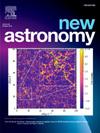变质量圆盘对Maxi J1659-152和Kepler-16变质量双星R3BP三角形平衡点附近运动区域和稳定性的影响
IF 2.1
4区 物理与天体物理
Q2 ASTRONOMY & ASTROPHYSICS
引用次数: 0
摘要
本文探讨了变质量圆盘对圆形受限三体问题(R3BP)中具有变质量双星Maxi J1659-152和Kepler-16的尘埃颗粒绕三角形平衡点运动区域和稳定性的影响。在梅斯切尔斯基统一定律(MUL)下,双星的质量随时间变化,它们的运动由gyl登-梅斯切尔斯基问题(GMP)描述,该问题假定系统被一个非离散的尘埃盘包围,在MUL的描述下,尘埃盘的质量也假定随时间变化。双星中的两个次级天体都被认为是辐射源。推导了时变方程组,并将其转化为常系数自治方程组。研究了自治系统和非自治系统的tep,发现自治系统存在一对由质量参数υ(磁盘质量μd)和质量变化参数κ定义的tep,而非自治系统的tep则由时间函数定义。可以看出,圆盘的径向和垂直尺度长度影响tep的位置,但这种影响主要取决于圆盘的质量。进一步研究了不同圆盘质量对tep周围尘埃颗粒零速度曲线(ZVC)的影响,发现随着圆盘质量的增加,能级降低,禁止尘埃颗粒运动的区域增大。此外,双星和tep周围允许运动的区域是由磁盘质量决定的。其次,我们研究了自主系统的线性稳定性,并发现它在两个双星的磁盘质量的某个区间内是稳定的。非自治系统的tep由于时间的原因是不稳定的。为了验证线性稳定性,我们探索了围绕tep的轨道数值积分,并计算了不同质量盘的Lyapunov指数指示器(LEI)。观察到轨道在线性稳定区间内是稳定的,相应的LEI趋于零。最后,我们分析了二元系统在线性不稳定TEPs范围内存在混沌,而在线性稳定TEPs范围内存在周期、准周期轨迹和孤岛。该模型可用于分析环境中具有质量变化的双星系统中卫星和行星的长期运动。该模型可用于分析环境中具有质量变化的双星系统中卫星和行星的长期运动。本文章由计算机程序翻译,如有差异,请以英文原文为准。
Impacts of variable mass disk on region and stability of motion around triangular equilibrium points of the R3BP with variable mass binaries Maxi J1659-152 and Kepler-16
The paper explores the impacts of variable mass disk on region and stability of motion of a dust grain around the triangular equilibrium points (TEPs) of the circular restricted three-body problem (R3BP), with variable mass binaries Maxi J1659-152 and Kepler-16. The masses of the binaries vary with time under the Mestschersky unified law (MUL) and their motion is described by the Gylden-Mestschersky problem (GMP), with the assumption that the system is enclosed by a non-discrete disk of dust whose mass is also assumed to vary with time under the description of the MUL. Both secondary bodies in the binaries are assumed to be radiation emitters. The time varying system of equations are deduced and transformed to the autonomized equations with constant coefficients. The TEPs of the autonomized and non-autonomous systems are investigated and it is seen that there exists a pair of TEPs defined by the mass parameter, mass of diskand the mass variation parameter, for the autonomized system while those of the non-autonomous system additionally are defined by a function of time. It is seen that the radial and vertical scale lengths of the disk affects the locations of the TEPs but this impact depends largely on the mass of the disk. Further, the impacts of the varying disks masses on the zero velocity curves (ZVC) of the dust grain around the TEPs, is investigated, and it is seen that, as the disk mass is increasing, the energy level decreases and the region where motion of the dust grain is forbidden increases. Additionally, the regions where motion is allowed around the binaries and the TEPs are determined by the disks masses. Next, we investigate the linear stability of the TEPs of the autonomized system and found it to be stable in some interval of the masses of the disks for both binaries. The TEPs of the non-autonomous system are unstable due to time. To validate the linear stability, we explore the orbital numerical integration around the TEPs and calculated the Lyapunov exponent indicator (LEI) for different masses of the disks. It was observed that the orbits are stable in the interval of the linear stability and their corresponding LEI tend to zero. Finally, we analyze the Poincaré surface of sections (PSS) around the TEPs for the binaries and found that in the range of linearly unstable TEPs, chaos exists while periodic, quasi-periodic trajectories and islands exist in the range of the linearly stable TEPS. This model can be used to analyze the long-term motion of satellites and planets in binary systems with mass variations of disk in the environment. This model can be used to analyze the long-term motion of satellites and planets in binary systems with mass variations of disk in the environment.
求助全文
通过发布文献求助,成功后即可免费获取论文全文。
去求助
来源期刊

New Astronomy
地学天文-天文与天体物理
CiteScore
4.00
自引率
10.00%
发文量
109
审稿时长
13.6 weeks
期刊介绍:
New Astronomy publishes articles in all fields of astronomy and astrophysics, with a particular focus on computational astronomy: mathematical and astronomy techniques and methodology, simulations, modelling and numerical results and computational techniques in instrumentation.
New Astronomy includes full length research articles and review articles. The journal covers solar, stellar, galactic and extragalactic astronomy and astrophysics. It reports on original research in all wavelength bands, ranging from radio to gamma-ray.
 求助内容:
求助内容: 应助结果提醒方式:
应助结果提醒方式:


